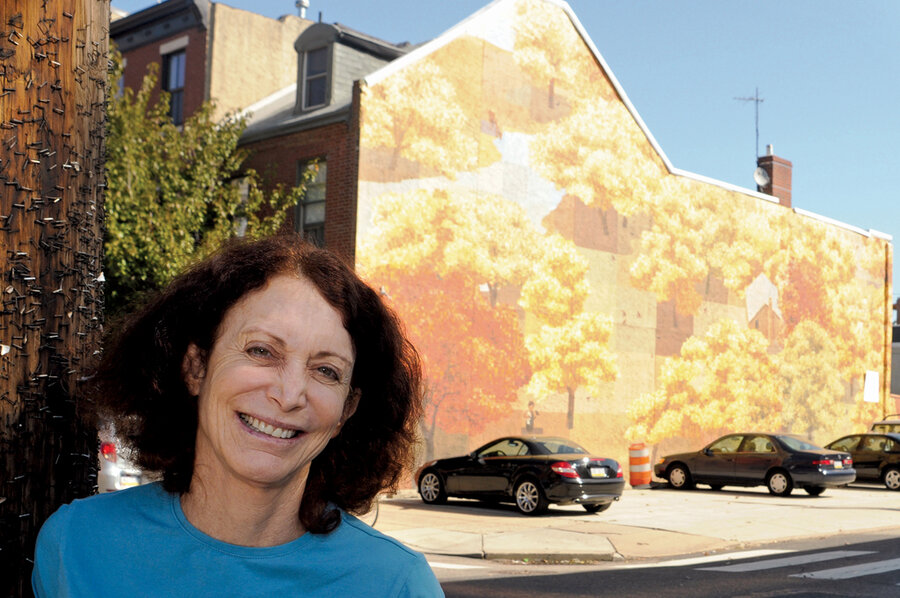She uses paint, brushes, and volunteers to clean up graffiti and build communities
Loading...
| Philadelphia
Twenty-six years ago, Jane Golden took to the streets of Philadelphia armed with paint, brushes, simple designs, and a small contingent of helpers.
Her goal? Wipe out the city's ugly graffiti. Her weapon of choice? Murals.
Today, 3,000 walls later, her work has morphed into the City of Philadelphia Mural Arts Program, the nation's largest such initiative, a joint, public-private mix of artmaking, art education, and art-as-therapy. A staff of 50 – many of them former graffiti artists themselves – helps her.
Since 1984 they have put paintbrushes in the hands of more than 35,000 city kids. They have brought art to prison inmates and drug addicts, as well as wary stoop sitters. The waiting list for murals to be painted here is 2,000 walls long. Artists far beyond Philly want in on the design work.
Under Ms. Golden's tenure, Philadelphia has become known as "The City of Murals." The murals now incorporate mosaics, fabric, plant materials, even light and sound, and her canvases go beyond just walls to places such as an oil refinery tank.
Some 15,000 visitors last year took tours of Golden's murals. Many who come are officials from Paris, Rome, London, and other cities seeking graffiti-prevention advice and insights into how Mural Arts keeps the murals so remarkably undefaced.
The answer lies in collaborating with residents on each mural, Golden says. Averaging 30 feet by 35 feet and costing about $20,000 each, the murals are not imposed on a neighborhood but rather reflect the nature of that neighborhood, whether it's love of a Philadelphia musical great such as Patti LaBelle or Mario Lanza or a plea for racial harmony.
Murals now embellish the city's upscale arts and business districts, as well as poor neighborhoods.
Overseeing the creation of some 100 murals a year, the small, wiry Golden covers lots of ground. She talks fast, wears sensible shoes, and dresses simply, even when joined by local Philadelphia VIPs for a ribbon-cutting ceremony.
Earlier this fall, some local dignitaries came together outside a North Philadelphia drug treatment center to dedicate "Personal Renaissance," a five-story-high, 12,000-square-foot depiction of the process of addiction and recovery.
The making of the mural involved some 1,200 participants over 18 months.
To Golden, making murals depicting heroes, seekers, and slogans is part of community building. Her formula has several steps. First, draw on talented young recruits from the Mural Arts art education program in the public schools.
Next, tap residents for design ideas. Then refine the design until you get it right. And, finally, encourage people to come out and paint.
When they do come out – to paint, to find out what's going on, to weigh in – residents discover that they can come together to accomplish other things, too – like dealing with a vacant lot or a littered street or a problem with a school.
"I love being a city employee," Golden says. "To me it's an honor to be part of government and to figure out ways to better the lives of people."
"She is an incredible public servant," says Philadelphia Mayor Michael Nutter. Golden has worked for four different mayors over the years.
Not everyone is a fan of public murals. Inga Saffron, architecture critic of the Philadelphia Inquirer, returned here from a stint as a Moscow correspondent to find murals "all over the place. It struck me how much they were like [old-fashioned] Soviet propaganda," she says.
In Russia, the message typically was "work harder," while here, she says, the message is more philosophical: "It's a small world after all/ we're all family/ everyone is good," but dogmatic nonetheless.
Ms. Saffron also objects to the sheer number of murals, and says that the young people served by the program could be put to work creating more diverse forms of public art, particularly now that covering up graffiti seems to be no longer the chief goal of the program.
Golden grew up in Margate, N.J., the daughter of art-loving parents who early on exposed her to the politically motivated posters that artist Ben Shahn created during the 1930s Depression.
That inspired her to work on murals in Los Angeles after she graduated from Stanford University in 1977 with a degree in fine arts and political science.
As Golden joined other officials at the massive Personal Renaissance wall outside the drug treatment center, local participants in the real-life drama of drug addiction stood tentatively at the fringes. The words on the mural came from poems written and painted by proud clinic attendees.
"We're showing the neighbors we're not just a bunch of drug addicts. We are a member of the neighborhood," said a patient who identified herself only as Pat.
Down the block, local resident Yesenia Lopez says the mural's words give the wall deep significance.
"If you read it – if you really read it – you can change your life," she says.
• For more stories about people making a difference, go here.





